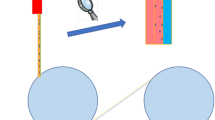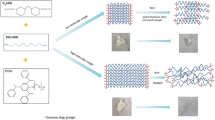Abstract
The solid–liquid (S–L) phase separation occurs in the polyethylene (PE)/liquid paraffin (LP) blend, which exhibits different characteristics for the molecular weight of PE. Herein, we have studied the S–L phase separation process of PE-500 (molecular weight of 5,000,000)/PE-60 (molecular weight of 600,000)/LP melts by the hot-stage-optical device. It is found that the clarification temperature and cloud temperature of PE-500/PE-60/LP blend decreased with the addition of PE-60. The isothermal crystallization behavior of these ternary blends is explored further using differential scanning calorimetry (DSC). According to the analysis results of Avrami equation and Arrhenius equation, the exponent n increases from 1.23 to 2.42 at higher temperature, indicating that the melt with high PE-60 content have a growth pattern between two and three dimensions, which could lead to larger pore. The activation energy at high temperature increases from 738.568 to 1321.259 \( {\text{kJ}}/{\text{mol}} \) with enhancing PE-60 content, while the activation energy decreases from 209.689 to 36.608 \( {\text{kJ}}/{\text{mol}} \) at lower temperature. It demonstrates that PE-60 content is not conducive to nucleation at high temperatures, but in favor of growth at low temperature. We believe the pore structure of PE microporous membrane may be controlled by different ratios of PE-500/PE-60 and crystallization temperature.







Similar content being viewed by others
References
Zuo J-H et al (2019) Fine tuning the pore size and permeation performances of thermally induced phase separation (TIPS) -prepared PVDF membranes with saline water as quenching bath. J Membr Sci 577:79–90
Xinya W, Changfa X, Hailiang L, Qinglin H, Hao F (2018) Fabrication and properties of PVDF and PVDF-HFP microfiltration membranes. J Appl Polym Sci 135:40. https://doi.org/10.1002/app.46711
Fan T, Li Z, Cheng B, Li J (2018) Preparation, characterization of PPS micro-porous membranes and their excellent performance in vacuum membrane distillation. J Membr Sci 556:107
Tan et al (2018) Preparation of bi-continuous poly(acrylonitrile-co-methyl acrylate) microporous membranes by a thermally induced phase separation method. J Appl Polym Sci 135:46173
Zhang C, Min Y, Bai Y, Gu J, Sun Y (2016) Fabrication and characterization of chlorinated polyvinyl chloride microporous membranes via thermally induced phase separation process. J Appl Polym Sci. https://doi.org/10.1002/app.44346
Ghodsi A, Fashandi H, Zarrebini M, Mirzaei M (2018) Controlling the morphology of PVDF hollow fiber membranes by promotion of liquid-liquid phase separation. Adv Eng Mater 20:1701169
Karkhanechi H et al (2016) Preparation and characterization of ECTFE hollow fiber membranes via thermally induced phase separation (TIPS). Polymer 97:515
Feng Y et al (2018) Preparation of polysulfone-graft-monoazabenzo-15-crown-5 ether porous membrane for lithium isotope separation. J Radioanal Nuclear Chem 317:111–119
Zuo DY, Zhu BK, Cao JH, Xu YY (2006) Influence of alcohol-based nonsolvents on the formation and morphology of PVDF membranes in phase inversion process. Chin J Polym Sci 24:281–289
Min L, Xu ZL, Chen DG, Wei YM (2010) Preparation and characterization of microporous PVDF membrane by thermally induced phase separation from a ternary polymer/solvent/non-solvent system. Desalination Water Treat 17:183–192
Cui ZY et al (2009) Preparation of PVDF-HFP microporous membranes via the thermally induced phase separation process. J Macromol Sci Part B 48:41–54
Wang Y, Ding T (2020) Crystallization kinetics and morphology of dynamically vulcanized poly(vinylidene fluoride)/silicone rubber blends. Polym Bull 77:671–686
Rajabzadeh S, Maruyama T, Sotani T, Matsuyama H (2008) Preparation of PVDF hollow fiber membrane from a ternary polymer/solvent/nonsolvent system via thermally induced phase separation (TIPS) method. Sep Purif Technol 63:415–423
Sonnenschein MF (1999) Hollow fiber microfiltration membranes from poly(ether ether ketone) (PEEK). J Appl Polym Sci 72:175–181
Liu S, Zhou C, Wei Y (2011) Phase separation and structure control in ultra-high molecular weight polyethylene microporous membrane. J Membr Sci 379:268–278
Wu YC, Cui YH, Jin HL, Ning CC (2015) Study on the preparation and thermal shrinkage properties of nano-SiO/UHMWPE/HDPE blend microporous membranes. J Appl Polym Sci 132:3. https://doi.org/10.1002/app.41321
Turell MB, Bellare A (2004) A study of the nanostructure and tensile properties of ultra-high molecular weight polyethylene. Biomaterials 25:3389–3398
Simis KS, Bistolfi A, Bellare A, Pruitt LA (2006) The combined effects of crosslinking and high crystallinity on the microstructural and mechanical properties of ultra high molecular weight polyethylene. Biomaterials 27:1688–1694
Tran QH, Brookhart M, Daugulis O (2020) New neutral nickel and palladium sandwich catalysts: synthesis of ultra-high molecular weight polyethylene (UHMWPE) via highly controlled polymerization and mechanistic studies of chain propagation. J Am Chem Soc 142:7198–7206. https://doi.org/10.1021/jacs.0c02045
Panin SV et al (2020) Effect of adhesion on mechanical and tribological properties of glass fiber composites, based on ultra-high molecular weight polyethylene powders with various initial particle sizes. Materials. https://doi.org/10.3390/ma13071602
Zhao C, He J, Li J, Tong J, Xiong J (2018) Preparation and properties of UHMWPE microporous membrane for lithium ion battery diaphragm. IOP Conf Ser Mater Sci Eng. https://doi.org/10.1088/1757-899X/324/1/012089
Li R, Ping G (2017) Nanoporous UHMWPE membrane separators for safer and high-power-density rechargeable batteries. Glob Chall 1:4. https://doi.org/10.1002/gch2.201700020
Ooms FGB et al (2001) Performance of Solupor® separator materials in lithium ion batteries. J Power Sour 97:598
Wang K, Zhou C, Zhang H, Zhao D (2002) Modification of polypropylene by melt vibration blending with ultra high molecular weight polyethylene. Adv Polym Technol 21:164–176
Chand N, Naik AM, Khaira HK (2007) Development of UHMWPE modified PP/PET blends and their mechanical and abrasive wear behavior. Polym Compos 28:267–272
Tong J, Ma Y, Jiang M (2003) Effects of the wollastonite fiber modification on the sliding wear behavior of the UHMWPE composites. Wear 255:734–741
Cai Y, Zhao L (2019) Investigation on the modification of N, N′-adipic bis(benzoic acid) dihydrazide on poly(L-lactic acid). Polym Bull 76:2295–2310
Tsuji H, Arakawa Y, Matsumura N (2019) Screening of crystalline species and enhanced nucleation of enantiomeric poly(lactide) systems by melt-quenching. Polym Bull 76:1199–1216
Lee SG, Kang TJ (1998) Preparation and crystallization behavior of UHMWPE/LLDPE composites. Polym Bull 40:95–102
Song S, Wu P, Ye M, Feng J, Yang Y (2008) Effect of small amount of ultra high molecular weight component on the crystallization behaviors of bimodal high density polyethylene. Polymer 49:2964–2973
He Z, Zhang Z, Bi S, Chen J (2020) Effect of polymer molecular weight on morphology and charge transport of small-molecular organic semiconductors. Electron Mater Lett 16:441–450
Sheng L et al (2020) Effects of cooling process on the solid–liquid phase separation process in ultra-high-molecular-weight polyethylene/liquid paraffin blends. Polym Bull 77:165–181. https://doi.org/10.1007/s00289-019-02733-y
Ferreira CI, Dal Castel C, Oviedo MAS, Mauler RS (2013) Isothermal and non-isothermal crystallization kinetics of polypropylene/exfoliated graphite nanocomposites. Thermochim Acta 553:40–48. https://doi.org/10.1016/j.tca.2012.11.025
He Z, Zhang Z, Bi S, Asare-Yeboah K, Chen J (2020) Ultra-low misorientation angle in small-molecule semiconductor/polyethylene oxide blends for organic thin film transistors. J Polym Res 27:75
Acknowledgements
Thanks for the support from Natural Science Foundation of Jiangsu Province (BK20160795), National Natural Science Foundation of China (51372115, 11575084) and Priority Academic Program Development of Jiangsu Higher Education Institutions (PAPD).
Author information
Authors and Affiliations
Corresponding author
Additional information
Publisher's Note
Springer Nature remains neutral with regard to jurisdictional claims in published maps and institutional affiliations.
Rights and permissions
About this article
Cite this article
Yang, Y., Sheng, L., Zhang, H. et al. Investigation on the solid–liquid (S–L) phase separation of the PE/LP blend with different molecular weight polyethylene. Polym. Bull. 79, 1521–1534 (2022). https://doi.org/10.1007/s00289-020-03510-y
Received:
Revised:
Accepted:
Published:
Issue Date:
DOI: https://doi.org/10.1007/s00289-020-03510-y




